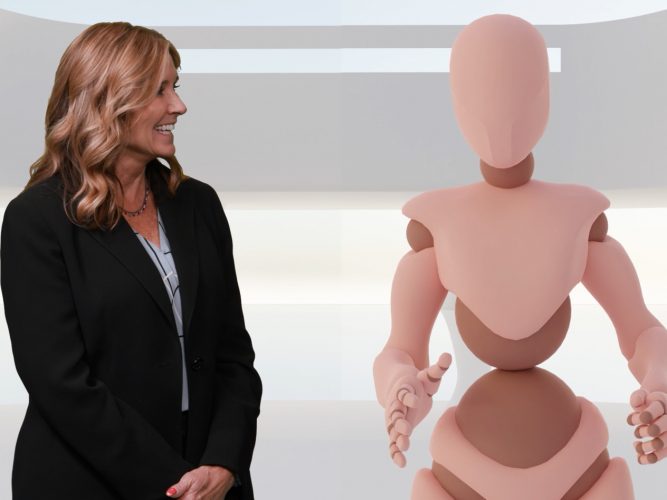Artificial intelligence already is having a seismic effect on business communications, thanks to the availability of ChatGPT and other AI tools. So, time is of the essence in getting MBA students up to speed on the potential—and the challenges—posed by this rapidly evolving technology.
Enter Generative AI for Communicators, a six-week course offered as part of WashU Olin’s Online MBA curriculum. Staci Thomas, professor of practice in management communications, said she developed the class to explain underlying models that direct AI tools, as well as how they are used in business communications.
“We wanted to take a realistic approach to the course and tell students how these models work,” Thomas said. “They need to understand the flaws and the biases while also understanding the potential.”
To prepare to launch the class, Thomas took several courses in AI, but she doesn’t see herself as an expert. “Rather than saying I know everything, I act as a facilitator and collaborate with people to create a course that covers all the different angles.”
She brings in experts in the use of generative AI in business communications, including industry professionals who already use it. Thomas worked with Olin Professor Salih Tutun, an AI expert, on the technical content and Seth Carnahan, an associate professor of strategy, on ethical issues related to AI.
“There’s an ethics element to every module,” Thomas said. “AI is rife with ethical issues.” She noted that the data set on which the models are based can be pulled from a variety of sources of varying quality. “So it’s pulling both from academic journals and from, say, Reddit.” The models can also mimic the biases of the humans who train them.
Despite these challenges, Thomas said the technology is already a vital business tool.
“I believe we have to embrace it,” she said. “As we talk to business professionals, they’re using it every day. We’re doing our students a disservice if we don’t show them how to use it well.”
An AI-powered assistant: Meet Synthia
To help illustrate the potential uses of AI technology, Thomas worked with the team at Olin’s Center for Digital Education, which provides e-learning support for the OMBA program, to craft a special virtual environment for the course.
AI was used to create background images and even a robot “teaching assistant” named Synthia.
“The robot was animated so that it could move and interact with Staci on the video,” said Jorge Delgado, a video production specialist with the CDE.
The script for Synthia’s dialogue was created in ChatGPT. Verity Woody, a multimedia developer at the CDE, said they used an AI tool called Speechify to convert the text to audio and design Synthia’s voice.
“You can make the voice as robotic or humanlike as you want,” she said. “I wanted to make it sound like she was a robot, but not a ‘beep-boop’ metallic-sounding robot.”
Despite the significant use of AI, Thomas said the team’s creative input was vital.
“We say we built it using AI, but it took humans to actually do it,” she said. “We talked about context, history, the understanding of the program and the students. There were critical questions these guys asked me throughout the development to make it work. It was undeniably a team effort.”
Those conversations allowed Delgado and Woody to work with AI tools while also considering their impact.
Woody said she sees the utility of AI. But she worries about the impact on human artists whose work could be appropriated without compensation or credit. “Like a lot of things, it can be used for good or for not-so-good things,” she said. “I hope we get regulations (to protect artists), but I think there can be a harmonious relationship with AI.”
Since AI technology is already so widely available, Delgado said professionals need to adapt to using it, while ensuring they’re doing so ethically.
“One interviewee (in the course) said something that really stuck with me: ‘It’s not that AI is going to take your job; it’s the people who can utilize AI to its full capacity who are going to take your job.’ It’s out there. If you don’t use it, you’re missing out on opportunities,” he said.
As AI continues to evolve and impact the business world, Thomas sees the potential to incorporate it into future courses. “I don’t think this should be the only course we have on AI—it’s a starter course. We’re putting a stake in the ground with this.”
AI tools used to create the Generative AI for Communicators course:
| ChatGPT 3.5 & 4 (with plugins) and Google Bard | language-processing chatbots that can generate humanlike text. |
| Bing AI | an AI-powered search engine and chatbot |
| Midjourney | a program that creates images from natural language descriptions |
| Speechify | an AI voice studio that translates text into voice files |
Pictured: Staci Thomas, professor of practice in management communications, and Synthia.



